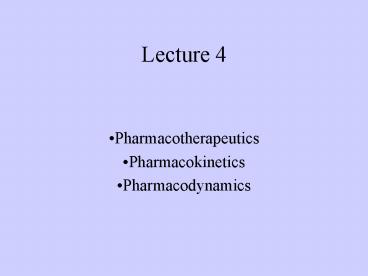Pharmacotherapeutics - PowerPoint PPT Presentation
1 / 36
Title:
Pharmacotherapeutics
Description:
Processes of drug absorption. Absorption is dependent on ... Phase 2 conjugation. Hepatic first pass phenomena. Enterohepatic cycling. Extrahepatic phenomena ... – PowerPoint PPT presentation
Number of Views:3183
Avg rating:3.0/5.0
Title: Pharmacotherapeutics
1
Lecture 4
- Pharmacotherapeutics
- Pharmacokinetics
- Pharmacodynamics
2
Pharmacotherapeutics / Indications
- Purposes of giving a drug
- Prevent illness
- Diagnose illness
- Relieve symptoms
- Treat and cure illness
3
Effective concentration is influenced by
- Pharmaceutical phase
- Pharmacokinetic phase
- Pharmacodynamic phase
4
Pharmaceutic Disintegration and dissolution
Rate limiting
5
Pharmaco kinetics
- How the body processes the drug
- Absorption
- Metabolism
- Distribution
- elimination
6
Pharmacokinetics
- Absorption
- Processes of drug absorption
7
Absorption is dependent on -Route of
administration
- Enteral route length of time in the stomach,
consumption of alcohol, solubility of the drug,
stability in gastric ph, interactions with other
food/ drugs, circulation in the GIT, surface area
for absorption - Parenteral route solubility, surface area for
absorption and circulation
8
Metabolism / biotransformation
- Occurs in two phases
- Phase 1 drug breakdown
- Phase 2 conjugation
- Hepatic first pass phenomena
- Enterohepatic cycling
- Extrahepatic phenomena
9
BIOAVAILABILITY
- Bioavailability
- fraction of administered drug that reaches the
systemic system - Factors which affect it
- Factors which affect the absorption
- Route of administration
- Changes in liver metabolism
10
BIOAVAILABILITY
11
Distribution process by which drug is carried
in the blood and delivered to the tissues and
cells
- Protein binding
- Lipid solubility
- Tissue affinity
- Amount of drug present in the tissues
- Cardiac output and blood supply
- Density of blood vessels in the tissues
- Placenta and blood brain barrier
12
Distribution (contd)
13
Distribution (contd)
14
Elimination
- Via the kidneys ( primarily), liver , GIT tract,
lungs , sweat glands, skin and breast milk
15
Half life (t ½)
- Half life
- time for plasma concentration of drug to be
eliminated by 50 - Affected by
- Metabolism
- Elimination
16
Pharmacodynamics
- Dose-response and maximal efficacy
- Onset, peak, and duration of action
17
Pharmacodynamics (contd)
- Receptor theory
18
Pharmacodynamcis
- Drug receptor activity
- Drug Receptor -gt Drug Receptor Complex -gt
Response - Drug receptor affinity affects potency.
- An agonist is a drug capable of combining with
receptors to initiate a drug response. - An antagonist is a drug that opposes or prevents
receptor response.
19
Agonists and Antagonists
20
(No Transcript)
21
Pharmacodynamics (contd)
- Nonspecific drug effect
22
Pharmacodynamics (contd)
- Nonselective drug effect
23
Pharmacodynamics (contd)
- Categories of drug action
- Stimulation or depression
- Replacement
- Inhibition or killing of organisms
- Irritation
24
- Therapeutic index
- the ratio of effective dose to lethal dose. A
wide TI means the drug is relatively safe.
25
(No Transcript)
26
Therapeutic Index
27
(No Transcript)
28
Therapeutic Index (contd)
- Therapeutic range (therapeutic window)
- Peak and trough levels, see Table 1-4
- Loading dose
- Side effects, adverse reactions, and toxic effect
- Pharmacogenetics
- Tachyphylaxis
- Placebo effect
29
Drug Effects
- To achieve therapeutic effect the drug must be
in appropriate concentration
30
Effects of Dosing on Pharmacokinetic Processes
- Steady state
- even distribution of drug concentration
- administration rate rate of clearance
- dependent on half-life
31
- Loading maintenance doses
- higher than usual dose needed to sustain
therapeutic effect - faster therapeutic effect than can be achieved
with steady state - Volume of distribution
- hypothetical volume of fat, blood, and total body
water in which drug appears distributed. - Highly water soluble drugs have a low Vd and
reach high serum levels. Drugs with high Vd are
more widely distributed in tissues. Figure is
used to help determine drug dose.
32
- Clearance
- rate of removal of drug from the body
- Tolerance
- successively larger doses of a drug are required
to maintain the same level of effect.
Tacyphlaxis when drug tolerance occurs
33
(No Transcript)
34
Implications for Nursing Management
- Maximizing therapeutic effect
- understand principles of drug action
- assess core patient variables to see if drug
action is typical - assess appropriateness of therapeutic regime
- assess appropriateness of administration site,
route, probable effects - assess drug to be given and time of
administration
35
Nursing Management cont.
- Minimize Adverse Effects
- make appropriate modifications to promote
effective action - monitor drug level
- assess for early signs of adverse effects
36
Summary

